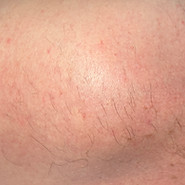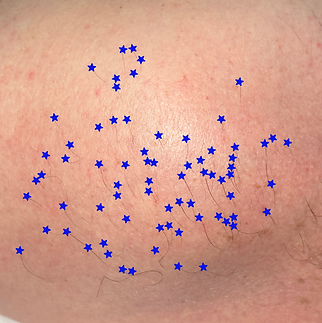toronto
downtown

conveniently book online!

CLICK/TAP
CALENDAR
ABOVE
email:
info@artofelectrolysis.ca
Text:
647 932 2251
How does electrolysis work?

probe inserted in a hair follicle. white glow around probe represents electric current's destructive pattern.
skin surface

SLOW-MO
how it works
Electrolysis permanent hair removal involves inserting a thin probe that's about the diameter of the hair into the hair follicle. A tiny amount of electricity is then released to destroy The hair producing cells within the follicle. as you can see in the slow-mo video, the hair is released without resistance after the current is applied. Each hair follicle is treated one by one.
the electrolysis process is not a one and done session. Not all hair follicles contain hairs at the same time because they have differing growth cycles. after all presently active follicles are treated, other previously inactive follicles will begin to sprout hairs. Only presently active follicles can be treated.
electrolysis typically requires regular treatment, which will eventually dwindle down to less frequent and shorter sessions, until there are no more follicles left to treat.
the amount of time it takes to treat an area will greatly depend on the density of hairs and the size of area being treated.

ILLUSTRATION OF ELECTROLYSIS PROCESS.
EMPTY INDENTATIONS REPRESENT FOLLICLES THAT are dormant and will eventually grow a hair.
before any treatment
end of treatment - no more follicles left to treat
after initial treatment(S)
after progressive treatments
after progressive treatments
note on assessing the permanence of electrolysis treatment on body hair*
generally speaking, the results of Permanent hair-reduction can be seen 3 months after the last treatment. the reduction in hair-density achieved at that 3 month mark will likely remain for a year or more.
Assessing the results at the 3 month mark may help to determine how well electrolysis or laser treatments are working and whether further treatment will be advantageous. Assessing the results prior to the 3 month mark may give an inaccurate sense of permanent reduction. please see bottom of this page for more info.
*doesn't always apply to facial hair
electrolysis terminology
clearance: to clear all hairs in the area being treated in a single sitting appointment or a few appointments which take place within a two week window
clearance method: to clear all hairs in a given area once every 3+ months. this applies to areas which have the maximum number of hairs present on the skin, meaning that no other hair removal methods, aside from clipping hairs with an electric trimmer to no shorter than 2-3 millimeters, are carried out for at least 3 months before the start of treatment or in between clearances. the clearance method is not feasible for clients who do not wish their hairs to be visible before or in between electrolysis sessions. due to time constraints, in large areas or areas that have a high density of hairs, an individualized treatment plan will be discussed.
electrolysis process examples
example of electrolysis process on a patch of man's shoulder hair with the 3 clearance method
man's shoulder hairs i have cleared four times, once every 3 months. photos below show the process of hair reduction 3 months after each treatment. no temporary hair removal methods or electrolysis was performed between the four treatments.
case will be updated 3 months after fourth clearance.
electrolysis plan: estimated to take 3 clearances, total, every 3 months to get the majority of follicles.
Pain: client described pain as 1 out of 10 but pain tolerance varies considerably from person to person.
healing: redness and swelling was present immediately after treatments and mostly subsided within 48 hours, with barely noticeable mild redness present for a few days after. no scabbing ever developed and there was no evidence of electrolysis treatment after one week.
notes on process photos of man's shoulder hair
timeline of man's shoulder hair case. note that the camera icon indicates that the corresponding numbered photos below were taken before treatment on the indicated date.
1
2
3
4
5
3.5 months between treatment
3 months between treatment
3 months between treatment
feb 12 2023
1st clearance
jun 3 2023
2nd clearance
sept 3 2023
3rd clearance
dec 2 2023
4th clearance (touch up treatment)
mar 3 2024 final results photo pending...

1

2

3

4
5
coming soon...

immediately after treatment
redness & swelling

skin surface
beside THE PROGRESS PHOTOS ARE THE SAME PHOTOS WITH THE HAIRS MAPPED. EACH STAR MARKS A HAIR AT THE POINT WHERE IT EXITS THE SKIN IN ORDER TO HELP VISUALIZE THE DENSITY REDUCTION.
THE CHANGING CONSTELLATION OF STARS ALSO HELPS VISUALIZE THAT IT IS NOT THE SAME FOLLICLES THAT ARE PRODUCING THE HAIRS IN FOLLOW UP APPOINTMENTS, MORE THAN 90% OF THE TIME, with the exception of some hairs i didn't get to due to time constraints of the appointment OR FOLLICLES THAT ARE VERY CLOSE.
close up photos of shoulder case with hairs mapped
1
before any treatment


mapped hairs on the before photo. EAch star is marking a hair at the point where it exits the skin.
2
permanent reduction after 1st clearance
photo taken 3.5 months after 1st clearance


3
permanent reduction after 2ND clearance
photo taken 3 months after 2ND clearance


4
permanent reduction after 3RD clearance
photo taken 3 months after 3RD clearance


5
permanent rESULT after TOUCH UP TREATMENt
FINal result photo taken 3 months after last treatment





4
5
coming soon...
shoulder case mapped process photos summary
1
3
2


example of electrolysis on a patch of arm hair
THIS is an example of a patch i treated on one of my electrolysis teachers who kindly volunteered his FOREarm. He had never used any temporary methods so as much hair as possible was present on the surface for me to treat. I had done one clearance, meaning: removed all the hairs present at one time, on the patch.
you can see the permanent reduction after just one clearance, in comparison to the surrounding areas still present a year later. The patch had not been touched with further electrolysis treatment or temporary methods between the first and only clearance and the photo below taken one year later.

immediately after electrolysis
PATCH that was cleared once, ONE YEAR LATER
healing after one week

my arm three years since the last electrolysis appointment
electrolysis done to completion on my arm
I've had my own lower arms treated to completion with electrolysis. within the span of around two years, of at first, regular treatment and then eventually the occasional treatment. My arm is now 99% clear.
note on assessing the permanence of electrolysis treatment on body hair continued
if as much body hair as possible is present on the surface for me to treat in a clearance, meaning the hair hasn't been removed by a temporary method such as shaving or waxing for at least 3 months and i remove all hairs present, then assessing the bulk of the permanent reduction after a treatment is established at approximately the 3 month or more mark. This means that generally the amount of new growth after 3 months indicates the permanent reduction of what's left.
in this way the 2 cases above indicate the permanent reduction, as the after photos are taken 3 months or longer from the last treatment. IN my own experience of assessing the long term permanent results from electrolysis and laser, I noticed the pattern of the permanent reduction i was left with at 3 months or more was what i was left with long term. this is also why some electrologists interval clearances of body hair to every 3 months.
assessing the reduction at a few weeks or 1-2 month mark often does not give an accurate account of the permanent long term reduction. an example of this can be waxing, if a leg is waxed, for it to reach the original full density can take up to around 3 months. at the one month mark after waxing, hair density can look reduced but this does not indicate the long term result of waxing which is generally temporary and will return to the original density present before waxing was performed after 3 months.
i say generally as it may be the case with finer hair that they may grow back slower and take longer to return to original desity after removal or there may be other exceptions.